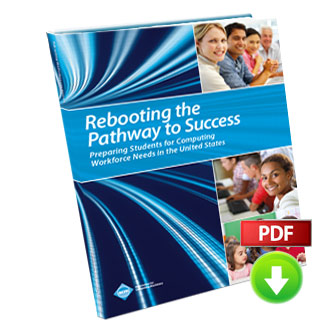Executive Summary
High-skilled, high-wage computing jobs are found in all regions of the country and in every significant industry sector. Industry leaders from inside and outside traditional technology companies widely recognize the growing demand for computing workers in many sectors. Nearly all of these jobs require a postsecondary degree. Immediate action is needed to increase the pipeline of qualified students obtaining computer science and other computing-related degrees, and to prepare them for the 21st century workforce.
To that end, state policymakers, educators, and workforce leaders should work together to create computer science education pathways essential to expanding students' career opportunities in computing-dependent occupations. These education pathways should expose all students to computer science and provide expanded access to more rigorous computer science courses.
To create effective pathways, each state should develop and implement computer science education and computing workforce plans that spread through all levels of the education system. These plans should foster increased opportunities for students in academic and career technical education programs to gain the computer science knowledge and skills needed to compete for high-wage employment. Key elements for achieving increased opportunities include: (1) the availability of and graduation credit for rigorous computer science courses in high school, (2) certified computer science teachers, (3) recognition of computer science courses in college admissions policies, (4) articulation agreements to allow for the efficient transfer of computer science courses across postsecondary institutions, and (5) actions to facilitate the full participation of women, minorities, and students with disabilities in computer science education and career pathways.
Unfortunately, current state standards and proposed STEM education reforms largely omit computer science from the core subjects that K-12 students are expected to learn. Only 17 states and the District of Columbia clearly allow an Advanced Placement (AP) computer science course to satisfy a core high school graduation requirement in mathematics or science. To promote academic quality, states or localities should adopt a clear definition of rigorous computer science that is grounded in the CSTA K-12 Computer Science Standards developed by the Computer Science Teachers Association (CSTA). Further, a rigorous computer science course should be recognized as a means for satisfying a core high school graduation requirement in computer science, mathematics, or science.
Expanding access to computer science for K-12 students is only one aspect of addressing current needs. Students can take computer science courses only if well-qualified teachers are available to teach them. Yet, the process of qualifying to teach computer science can be difficult to discover and difficult to achieve. To ensure that teachers achieve excellence in their daily work, states or localities should establish clear, relevant, and attainable requirements for computer science teacher certification.
Two-year and four-year postsecondary institutions represent critical components of these education pathways. By recognizing computer science courses in admissions, they can create incentives for high school students to acquire the academic background needed for postsecondary pathways that can lead to high-wage computing careers. Higher education institutions also can reduce barriers to degree completion by adopting comprehensive, system-wide articulation agreements to help students who move from two-year to four-year institutions complete their computer science and other computing-related degrees efficiently and effectively.
Underpinning all of these efforts is the need for computer science education pathways that promote a diverse and inclusive computing workforce. Developing a broad-based pool of computing talent reflective of the country's demographics is crucial to expanding technological innovation vital to the country's growth and the success of U.S. businesses. Economic realities dictate that the United States needs to greatly increase the share of women, Hispanics/Latinos, Blacks/African Americans, and other currently underrepresented groups in the computing workforce.
Satisfying the growing national demand for a skilled computing workforce poses significant challenges. Several exemplary computer science education initiatives across the country serve as potential models to overcome these challenges. Representative examples of these initiatives, as described in this report, offer inspiration to increase access to computer science education, address issues of diversity, and provide all students with the foundational computer science knowledge and skills important to success in virtually every career.


 Download the Report in PDF (4 MB)
Download the Report in PDF (4 MB)


